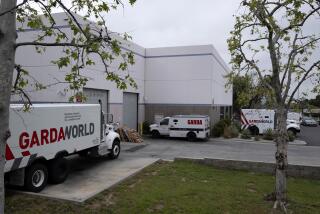Suit Outlines How Lincoln Allegedly Generated Phony Profits for Parent
- Share via
Hidden Valley Ranch, 8,576 acres of undeveloped land southwest of Phoenix, is largely barren and, as its name implies, is difficult to reach.
But what was hidden from most observers was not so much the valley as the way that its owner, Lincoln Savings & Loan, allegedly used the land to generate phony profits from fraudulent transactions, according to the $1.1-billion racketeering lawsuit that federal regulators filed last week against Charles H. Keating and other former operators of the Irvine thrift.
The bogus profits boosted the amount that Lincoln forwarded to its parent, American Continental Corp. in Phoenix, ostensibly to pay its share of corporate taxes, the suit claims.
The tax-sharing plan was one of the ways in which the parent firm allegedly drained Lincoln funds to fuel American Continental’s speculative real estate deals and enrich its owners, the suit contends.
Insiders benefited, the suit alleges, from excessive loans made by Lincoln to companies that they controlled and from American Continental’s stock value, boosted by the unusually healthy financial results that Lincoln was posting with inflated revenue. Keating sold some of his stock in 1987, for instance, for $3.3 million, which was in addition to his $2-million salary.
Regulators seized Lincoln on April 14, a day after American Continental filed for bankruptcy, saying the S&L; was being operated in an unsafe manner. Experts predict that Lincoln will be the nation’s costliest S&L; bailout, costing taxpayers up to $2.5 billion.
Tax-sharing plans allow a subsidiary to send its share of taxes to its parent, which pays the entire tax bill for the holding company and all subsidiaries.
Under Lincoln’s arrangement with its parent, the suit alleges, Lincoln funneled federally insured deposits into a series of questionable deals that created artificial profits--and allowed the S&L; to ship a total of $94.8 million to its parent for taxes over three years.
But Lincoln didn’t have any taxable income for those years and, therefore, didn’t owe any taxes, the suit claims. Nor did American Continental use the money that Lincoln forwarded under the tax-sharing plan to pay taxes, the suit alleges. “The true but hidden purpose of the arrangement was to allow ACC to siphon funds from . . . Lincoln for the enrichment of ACC,” Keating and his family and associates, the suit states.
The Hidden Valley deals, as well as other transactions cited in the suit, also helped Lincoln get around regulations designed to limit its ownership interests in real estate and securities, the suit claims. Because the transactions were shams arranged by insiders, the suit states, Lincoln never really sold its investments and still controlled those assets.
A spokesman for American Continental would not comment on allegations in the suit, saying the company would make its response in court.
Corporate executives previously denied all wrongdoing, specifically stating that loans and sales that Lincoln made were not contrivances to hide unlawful direct investments. They have said repeatedly that regulators had spent the past four years reviewing their records and even approved some transactions. Nothing in the lawsuit, one spokesman said last week, comes as a surprise.
All Loans Defaulted
A Lincoln subsidiary bought the vacant Hidden Valley land for about $28.6 million and, from October, 1986, through June, 1988, sold three-quarters of it in the 10 transactions. It recorded a profit of nearly $82.1 million, which resulted in $31 million being sent to American Continental for taxes.
The transactions characteristically involved “straw” men who borrowed the entire purchase price directly or indirectly from Lincoln to buy the property, the suit said. And Lincoln assumed the risk of possible losses because the borrowers were allowed to limit their risk of default to the property itself, the suit said. All the loans defaulted, the suit said.
In one of those transactions, Ernest C. Garcia went to Keating and his associates for a loan early in 1987 to buy the remaining stock in a Phoenix real estate development and investment banking firm, according to the lawsuit. Garcia already owned 20% of what now is called E. C. Garcia & Co.
A major condition for providing the loan, however, was Garcia’s agreement to buy or arrange for the purchase of a 1,000-acre parcel of Hidden Valley for $14 million, the suit claims.
Garcia could not or would not buy the parcel, but he arranged for Westcontinental Mortgage & Investment Corp. to buy the parcel and satisfy Keating’s demand, a requirement that allegedly violated federal law.
On March 30, 1987, Lincoln loaned Garcia $20.2 million. While Garcia used a “significant” portion of the loan to buy Garcia Co. stock, the suit alleges, he also loaned Westcontinental $3.5 million on the same day for that company’s down payment on the Hidden Valley property.
At the same time, Westcontinental borrowed $10.5 million from a Lincoln subsidiary for the remaining amount owed.
More to Read
Inside the business of entertainment
The Wide Shot brings you news, analysis and insights on everything from streaming wars to production — and what it all means for the future.
You may occasionally receive promotional content from the Los Angeles Times.










